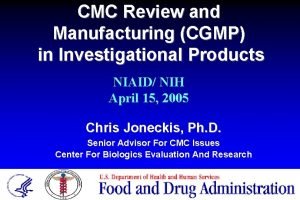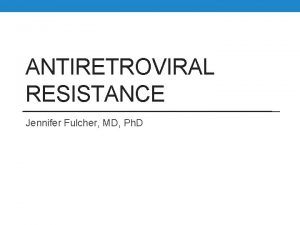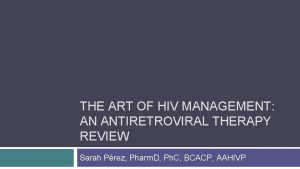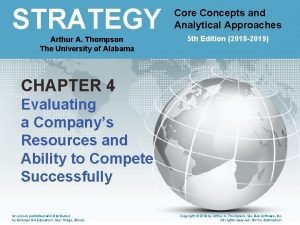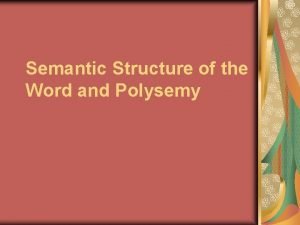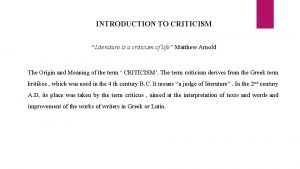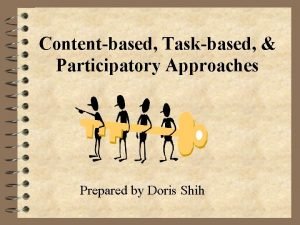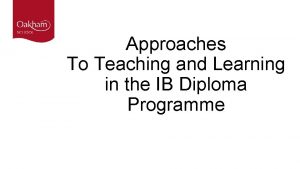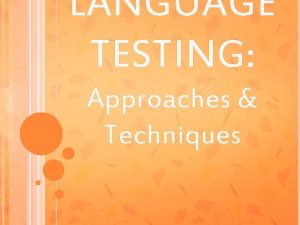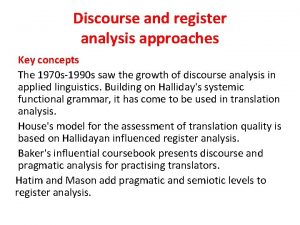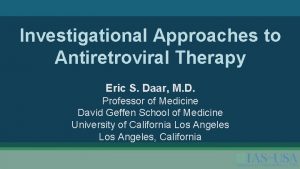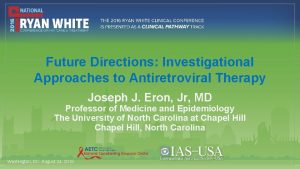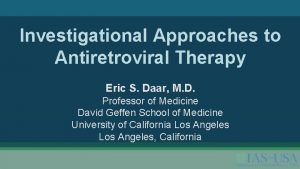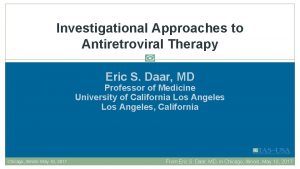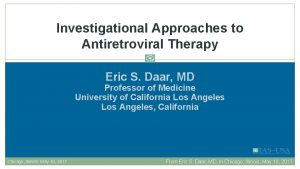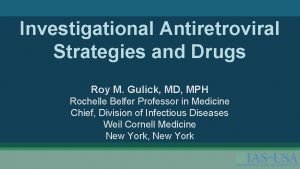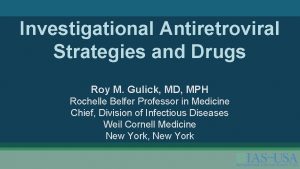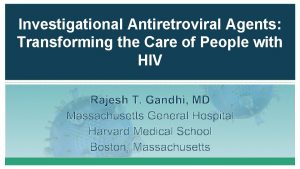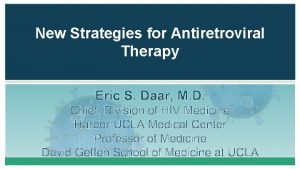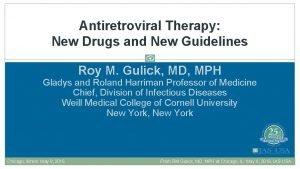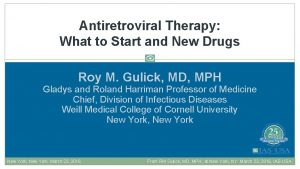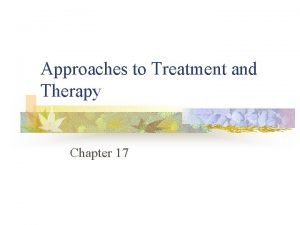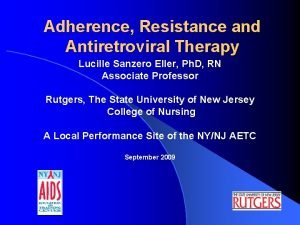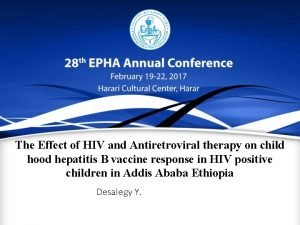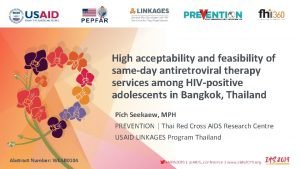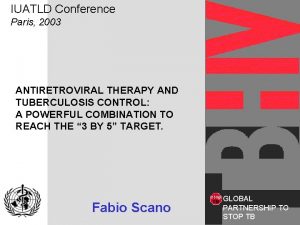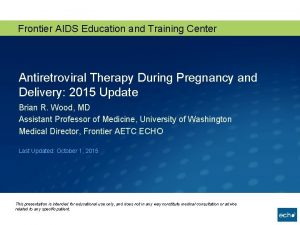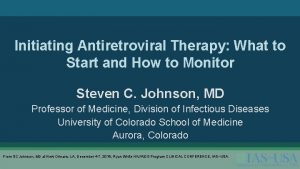Investigational Approaches to Antiretroviral Therapy New Strategies and



































- Slides: 35

Investigational Approaches to Antiretroviral Therapy: New Strategies and Novel Agents Joseph J. Eron MD Professor of Medicine University of North Carolina Chapel Hill, North Carolina

Financial Relationships With Commercial Entities Dr Eron has served as an ad hoc consultant to Janssen, Vii. V Healthcare, Merck, and Gilead Sciences, Inc. His institution receives contracts for clinical research on which Dr Eron is the local principal investigator from Janssen Therapeutics, Vii. V Healthcare, and Gilead Sciences, Inc.

Learning Objectives After attending this presentation, learners will be able to: ▪ List several two-drug combinations that are being evaluated for initial or maintenance therapy ▪ Describe characteristics of the long acting injectable antiretroviral therapy in late-stage development ▪ Describe the mechanisms of action and potential uses of 2 entry inhibitors in development for patients with resistant virus

Outline of the Talk ▪ New Two-drug Strategies for Initial ART and treatment switch (long-acting therapy) ▪ Novel Agents for Resistant Virus ▪ New Agents in Early Development

ARS Question 1 • Your ”go to” initial ART is 1. 2. 3. 4. 5. 6. 7. Bictegravir/FTC/TAF Dolutegravir/abacavir/lamivudine Dolutegravir plus TAF (or TDF)/FTC Elvitegravir/cobi/TAF (or TDF)/FTC Darunavir/r (or cobi) plus TAF(or TDF)/FTC Rilpivirine/TAF (or TDF)/FTC Something else

What is needed for initial therapy? • We have convenient, safe, effective unboosted integrase inhibitor therapy – do we need something else? • Alternatives to INSTI – based therapy? – NNRTI – based therapy • with better tolerability, • less resistance and fewer dosing restrictions? – PI - based therapy • more convenient • Fewer drug-drug interactions • Exposure to fewer agents? – Two drug combinations • Alternative dosing strategies

Two Drug Regimens for Initial Therapy • Rationale – ”nuc-sparing” – a need that seems less critical now • advanced renal disease or TFV or ABC intolerance – Minimize ARV exposure for therapy that will last for decades – Cost • Strategies – Boosted PI plus INSTI (NEAT 001) – Boosted PI plus 3 TC (GARDEL and ANDES studies) – Dolutegravir plus 3 TC (PADDLE, A 5353, GEMINI)

Snapshot Analysis by Visit: Pooled ITT-E Population Adjusted treatment difference (95% CI) at Week 48 a Virologic outcome HIV-1 RNA <50 c/m. L, %b 100 80 60 40 20 0 -20 87 89 90 72 858988 70 93 93 91 90 93 91 [ C DTG + 3 TC (N=716) E DTG + TDF/FTC (N=717) L L R E -4 0 F 4 8 12162024283236404448 ] Study visit DTG + TDF/FTC Intention-totreat–exposed -1. 7 -4. 4 Per protocol -3. 9 DTG + 3 TC 1. 1 -1. 3 1. 2 -10 -8 -6 -4 -2 0 2 4 6 8 10 DTG + 3 TC is non-inferior to DTG + TDF/FTC with respect to proportion achieving HIV-1 RNA <50 c/m. L at Week 48 (snapshot, ITT-E population) in both studies a. Based on Cochran-Mantel-Haenszel stratified analysis adjusting for the following baseline stratification factors: plasma HIV-1 RNA (≤ 100, 000 vs >100, 000 c/m. L) and CD 4+ cell count (≤ 200 vs >200 cells/mm 3). b. Calculated from a repeated measures model adjusting for study, treatment, visit (repeated factor), baseline plasma HIV-1 RNA, baseline CD 4+ cell count, treatment and visit interaction, and baseline CD 4+ cell count and visit interaction. Cahn et al. Lancet. 2018 [Epub ahead of print]. Slide 11 of 37 Eron et al. HIV DART and Emerging Viruses 2018; Miami, FL. Slides 7.

Proportion of Participants With Plasma HIV-1 RNA <50 c/m. L at Week 48 (Snapshot Analysis) by Baseline Plasma HIV-1 RNA DTG + TDF/FTC (N=717) Baseline viral load strata DTG + 3 TC (N=716) DTG + TDF/FTC ≤ 100, 000 c/m. L 531/564 526/576 94 91 >100, 000 c/m. L 138/153 129/140 90 92 >250, 000 c/m. L 41/46 45/51 89 88 >400, 000 c/m. L 20/24 16/18 83 89 >500, 000 c/m. L 12/15 11/13 0 80 85 20 40 60 80 HIV-1 RNA <50 c/m. L, % Slide 12 of 37 Cahn et al. Lancet. 2018 [Epub ahead of print]. DTG + 3 TC -2. 8 1. 9 -0. 9 5. 6 4. 6 100 -30 -20 -10 0 10 20 30 40 Difference in proportion, % (95% CI) Eron et al. HIV DART and Emerging Viruses 2018; Miami, FL. Slides 7.

ARS Question 2 • Based on the GEMINI 48 week data, in what setting will you use dolutegravir/3 TC? 1. As initial therapy with any baseline viral load 2. As initial therapy in specific patients with lower viral loads 3. As maintenance therapy in patients who are suppressed on 3 -drug treatment 4. I will wait until we have longer term (96 week data) with DTG/3 TC to decide 5. Only when insurance companies tell me to use it 6. Something else

LATTE-2: Study of Long Acting Cabotegravir and Rilpivirine – 96 week data Maintenance perioda Induction period Inclusion criteria CAB loading dose at Day 1 (800 mg) CAB 30 mg + ABC/3 TC PO QD CAB 30 mg + for 20 weeks ABC/3 TC for (N=309) 20 weeks Exclusion criteria CAB 400 mg IM + RPV 600 mg IM • ≥ 18 years old Q 4 W (n=115) • Naive to antiretroviral therapy • CD 4+ ≥ 200 cells/mm 3 CAB 600 mg IM + RPV 900 mg IM Q 8 W (n=115) • Positive for hepatitis B • ALT ≥ 5 × ULN • Creatinine clearance <50 m. L/min CAB loading doses at Day 1 (800 mg) and Week 4 (600 mg) CAB 30 mg + ABC/3 TC PO QD (n=56) Add RPV PO QD Qualification for maintenance • HIV-1 RNA <50 c/m. L between Week -4 and Day 1 4 weeks Day 1 Randomization 2: 2: 1 Week 32 Primary analysis Dosing regimen selection Week 96 b Week 48 Analysis Dosing regimen confirmation ABC/3 TC, abacavir/lamivudine; ALT, alanine aminotransferase; IM, intramuscular; PO, orally; QD, once daily; Q 4 W, every 4 weeks; Q 8 W, every 8 weeks; ULN, upper limit of normal. a. Subjects who withdrew after at least 1 IM dose entered the long-term follow-up period. b. Subjects can elect to enter Q 4 W and Q 8 W LA extension phase beyond Week 96. Eron et al. IAS 2017; Paris, France. Slides MOAX 0205 LB.

Comparable Response Across Arms Week 96 HIV-1 RNA <50 c/m. L by Snapshot (ITT-ME) Virologic outcomes Treatment differences (95% CI) IM Oral HIV-1 RNA <50 c/m. L, % 100 94 87 84 CAB + RPV LA Q 8 W (n=115) CAB + RPV LA Q 4 W (n=115) CAB + NRTIs PO (n=56) 80 Q 8 W IM 10. 0% − 0. 6% 60 40 Q 4 W IM 13 14 20 4 0 20. 5% Virologic success 0 2 Virologic nonresponse 3. 0% 2 No virologic data − 8. 4% -12 -9 14. 4% -6 -3 0 3 6 9 12 15 CAB, cabotegravir; CI, confidence interval; IM, intramuscular; ITT-ME, intent-to-treat maintenance exposed; LA, long acting; NRTI, nucleoside reverse transcriptase inhibitor; PO, orally; Q 4 W, every 4 weeks; Q 8 W, every 8 weeks; RPV, rilpivirine. Eron et al. IAS 2017; Paris, France. Slides MOAX 0205 LB.

Latte 2 Outcomes at 160 Weeks

Letendre Glasgow 2018

LA CAB and LA RPV Phase III studies • ATLAS – randomized, open label, non-inferiority study in participants stably suppressed on 3 -drug ART comparing CAB LA 400 mg + RPV LA 600 mg q 4 weeks with maintenance of current ARV regimen (2 NRTIs plus an INI, NNRTI, or a PI). 618 participants were randomized (1: 1) to continue current ART or switch to oral therapy with CAB 30 mg + RPV 25 mg daily for 4 Weeks followed by Q 4 weekly CAB LA + RPV LA injections. • FLAIR - randomized, open label, non-inferiority study in ART-naïve adult participants comparing CAB LA 400 mg + RPV LA 600 mg q 4 weeks to remaining on ABC/DTG/3 TC over 48 weeks. 631 participants started ABC/DTG/3 TC for 20 weeks and those with HIV RNA <50 c/m. L after 16 weeks were randomized at 20 weeks to continue ABC/DTG/3 TC or switch to oral therapy with CAB 30 mg + RPV 25 mg daily for 4 week, followed by monthly CAB LA + RPV LA injections • Both studies met their primary endpoints at 48 week (Vii. V Press Releases) • ATLAS-2 M study compares q 8 wk CAB LA + RPV LA to q 4 wk CAB LA + RPV LA over a 48 -week treatment period in approximately 1020 adult HIV-1 infected subjects.

Recently approved or in Phase III NEW THERAPY FOR RESISTANT VIRUS

HIV Entry Inhibitors CD 4 Binding Coreceptor Binding CCR 5 Inhibitors maraviroc* gp 41 fostemsavir Virus-Cell Fusion enfuvirtide* gp 120 ibalizumab V 3 loop CD 4 Cell Membrane * = FDA approved CCR 5/CXCR 4 (R 5/X 4) Slide courtesy of Trip Gulick, MD; Adapted from Moore JP, PNAS 2003; 100: 10598 -10602.

Ibalizumab • Humanized monoclonal Ab: binds CD 4 on host cells; blocks HIV entry (post attachment inhibitor)1 • Active against CCR 5 and CXCR 4 tropic HIV • No cross resistance with other ARVs 2 • IV infusion: 2, 000 mg loading dose then 800 mg every 2 wks • Duration of infusion: 15 -30 min 1 Emu B et al, Abstract 1686, IDWeek 2017; 2 Weinheimer S et al, CROI 2018 Slide courtesy of Raj Gandhi 18

Ibalizumab in Persons with Multi-Drug Resistant HIV • Phase 3 trial: 40 heavily treatment experienced pts with 3 -class ARV resistance, ≥ 1 active drug • Primary endpt: VL drop >0. 5 log 10 c/m. L: • 3% during control period • 83% after loading dose • Regimen optimized at day 14 • Wk 24: VL <200 in 50% • Expanded access: viral suppression to wk 48 • A Approved March 6, 2018 Emu B et al, Abstract 1686, IDWeek 2017; Weinheimer S et al, CROI 2018, #561 19

Fostemsavir (FTR): Oral HIV Attachment Inhibitor • Prodrug of temsavir: binds to gp 120, inhibits HIV attachment to CD 4 • Phase 3 trial in heavily treatment experienced patients with VF (BRIGHTE) Kozal M et al, 16 th EACS, 2017 Slide courtesy of Raj Gandhi

Fostemsavir (FTR): Phase 3 Trial (BRIGHTE) Mean VL Change at day 8 Adjusted Mean† (95% CI) 0 N=69 Placebo -0. 2 -0. 4 Virologic response through wk 24 (observed analysis) N=201§ FTR 600 mg BID -0. 17 -0. 6 -0. 8 -0. 79 -1 Difference† (95% CI) = -0. 625 (-0. 810, -0. 441) P<0. 0001‡ Kozal M et al, 16 th EACS, 2017 “Regulatory submissions are currently anticipated to take place in the 2019/2020 timeframe” At wk 24, 54% of randomized and 36% of nonrandomized ppts who received FTR + OBR achieved VL Slide courtesy of Raj Gandhi <40 https: //www. viivhealthcare. com/media/press-releases/2017/october/viiv-healthcare-announces-positive-phase-3 -results-from-the-brighte-study-of-fostemsavir-in-heavily-treatmentexperienced-patients-with-hiv. aspx

BRIGHTE: Efficacy at Wk 48 (FDA Snapshot) Outcome at Wk 48, n (%) Randomized Cohort (n = 272) Nonrandomized Cohort (n = 99) 146 (54) 38 (38) 187 (69)/191 (70) 43 (43)/44 (44) 104 (38) 52 (53) 72 (26) 33 (33) § D/c for lack of efficacy 6 (2) 2 (2) § D/c for other reason while not below threshold 9 (3) 3 (3) § Change in OBT 17 (6) 14 (14) 22 (8) 9 (9) § D/c due to AE or death 15 (6) 8 (8) § D/c due to other reasons 5 (2) 1 (1) 2 (< 1) 0 127 (54 to 204) 35 (-1 to 121) HIV-1 RNA < 40 c/m. L (virologic success) HIV-1 RNA < 200 c/m. L/< 400 c/m. L HIV-1 RNA ≥ 40 c/m. L (virologic failure) § Data in window not below threshold No virologic data § Missing data during window but on study Median CD 4+ cell count change vs BL, cells/mm 3 (IQR) Aberg. Glasgow 2018. Abstr O 344 A. Reproduced with permission.

NOVEL AGENTS IN EARLY DEVELOPMENT


Long-acting NRTTI: MK-8591 (EFd. A) Phase 1 b, single-dose, monotherapy study Study population: ART naïve (N=30) Change From Baseline HIV-1 RNA (log 10 copies/m. L) • MK-8591 0. 5 mg MK-8591 1 mg MK-8591 2 mg 0. 0 MK-8591 10 mg MK-8591 30 mg -0. 5 -1. 0 -1. 5 -2. 0 -2. 5 0 2 4 6 Time (days) 8 10 Grobler et al CROI 2017 #435 Matthews et al IAS 2017 #TUPDB 0202 LB

Long-acting NRTTI: MK-8591 (EFd. A) • Study in healthy volunteers: daily doses as low as 0. 25 mg expected to lead to HIV suppression MK-8591 achieve target levels with only 0. 25 mg dose • Phase 2 b trial in people with HIV, in combination with doravirine (NNRTI) and 3 TC, has started (DRIVE 2 Simplify) • Daily dosing • Potential for once weekly or even once monthly dosing • “Partners wanted” Matthews RP et al CROI 2018 #26 https: //clinicaltrials. gov/ct 2/show/NCT 03272347

Grobler et al CROI 2016

GS-6207 HIV Capsid Acts at Multiple Stages in the Viral Life Cycle TARGET CELL Reverse Transcription PRODUCER CELL X Capsid Core Assembly Gag X NUCLEUS Capsid Core Disassembly Gag-Pol Maturation Preintegration complex X Nuclear Translocation NUCLEUS Capsid Core Integration Capsid Core Gilead’s capsid inhibitors inhibit HIV capsid function, resulting in aberrant core assembly/disassembly via multiple steps in HIV replication cycle Tse W, et al. CROI 2017. Seattle, WA. Oral #38

GS-6207: Novel HIV Capsid Inhibitor with Long-Acting Potential Potency 1500 Human PBMCs MT-4 cells Mean: 50 p. M Range: 20– 160 p. M Antiviral EC 50, p. M CAB 1000 RPV GS-6207 500 0 HIV-1 IIIb A B C D EC 50 (n. M)a pa. EC 95 (n. M)b GS-6207 0. 10 ± 0. 01 4. 0 ± 0. 4 EFV 0. 79 ± 0. 06 44 ± 3 RPV 0. 57 ± 0. 03 45 ± 2 DTG 1. 34 ± 0. 14 156 ± 16 ATV 7. 23 ± 0. 50 150 ± 11 E F G CRFs HIV-1 Subtype GS-6207 is a potent inhibitor of all major HIV-1 subtypes GS-6207 is more potent than currently marketed ARVs ATV, atazanavir. DTG, dolutegravir. EFV, efavirenz. pa. EC, protein-adjusted effective concentration. RPV, rilpivirine EC 50, CC 50 and Hill slope values (mean ± SD) obtained from at least 3 independent experiments performed in quadruplicate b EC 1/hillslope; pa. EC = human serum shift X EC 95 = EC 50 x (95/5) 95 95 a Zheng J, et al. IDWeek 2018. San Francisco, CA. Poster #539

GS-6207: Novel HIV Capsid Inhibitor with Long-Acting Potential Plasma PK in Rats and Dogs Following a Single SC Dose* 24 wks 4 pa. EC 95 § Single subcutaneous injection maintains plasma concentrations well above pa. EC 95 for >24 weeks in dogs § PK supports long acting administration, potentially Q 3 M or longer, in humans pa. EC 95, plasma-binding-adjusted effective concentration required to inhibit replication by 95% * 400 mg/m. L dose concentration Zheng J, et al. IDWeek 2018. San Francisco, CA. Poster #539

Broadly Neutralizing Antibodies against HIV Phase 2 studies in HIV infected patients Clear antiretroviral activity Combinations likely necessary Can be modified for longer half-life Every 3 to 6 month infusions possible

September 27, 2018 Combination b. NAb, long-acting b. NAb being studied for treatment, prevention

Antiretroviral Therapy: The Future Implantable ART b. NAbs for therapy Long Acting Injectable? 2 -drug regimens The Integrase Era Single Tablet Regimens Triple Drug Therapy ZDV/3 TC ZDV monotherapy HIV-1 discovered 1983 1987 1995 1996 2006 2012 -13 2019 2025

Acknowledgements • Judy Currier • Dan Kuritzkes • Raphael Landovitz • Carey Hwang • Michael Aboud • Chloe Orkin • Kathleen Squires • Trip Gulick • Raj Gandhi • Jay Glober

Question-and-Answer
 Investigational product manufacturing
Investigational product manufacturing Antiretroviral
Antiretroviral Antiretroviral
Antiretroviral Develop new approaches to public governance and engagement
Develop new approaches to public governance and engagement Psychodynamic and humanistic therapies have in common
Psychodynamic and humanistic therapies have in common Bioness bits cost
Bioness bits cost Humanistic therapies aim to boost
Humanistic therapies aim to boost New approaches to organizing hr
New approaches to organizing hr Human resource management chapter 1
Human resource management chapter 1 Human resource management global edition
Human resource management global edition New approaches to sme financing
New approaches to sme financing New product development and product life cycle strategies
New product development and product life cycle strategies Wii hab
Wii hab Risk reduction strategies for new entry exploitation
Risk reduction strategies for new entry exploitation Risk reduction strategies for new entry exploitation
Risk reduction strategies for new entry exploitation Risk reduction strategies for new entry exploitation
Risk reduction strategies for new entry exploitation New york pennsylvania new jersey delaware
New york pennsylvania new jersey delaware Fresh oil, new wine scripture
Fresh oil, new wine scripture Characteristics of the articles of confederation
Characteristics of the articles of confederation Kotler e keller
Kotler e keller New classical macroeconomics
New classical macroeconomics Chapter 16 toward a new heaven and a new earth
Chapter 16 toward a new heaven and a new earth Neil thisse is a loyalist who fled the colonies
Neil thisse is a loyalist who fled the colonies New classical and new keynesian macroeconomics
New classical and new keynesian macroeconomics What is wad approach
What is wad approach Strategy core concepts and analytical approaches
Strategy core concepts and analytical approaches Semantic structure of a word
Semantic structure of a word Intrinsic and extrinsic approach to literature
Intrinsic and extrinsic approach to literature Approaches formalism and substantivism
Approaches formalism and substantivism Content based task based and participatory approaches
Content based task based and participatory approaches Health promotion approaches
Health promotion approaches Approach to learning ib
Approach to learning ib Structuralist approach
Structuralist approach Discourse and register analysis approaches
Discourse and register analysis approaches What is quasi experimental research
What is quasi experimental research Characteristics of direct instruction
Characteristics of direct instruction
